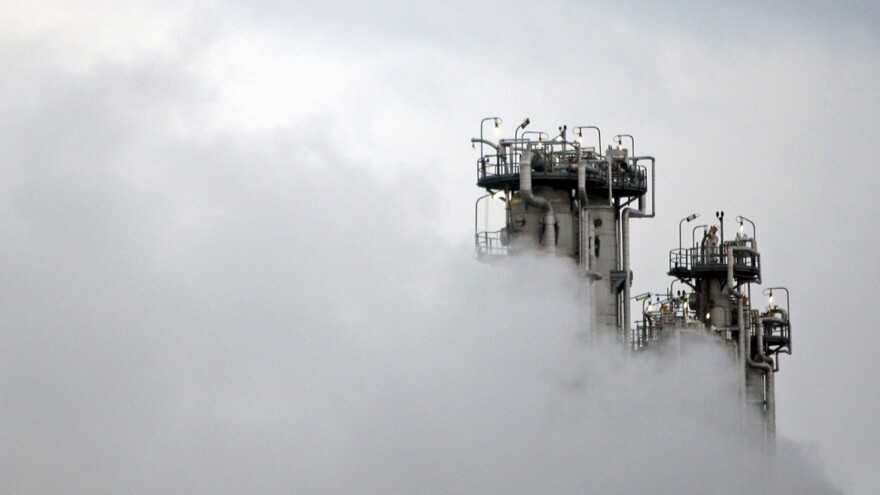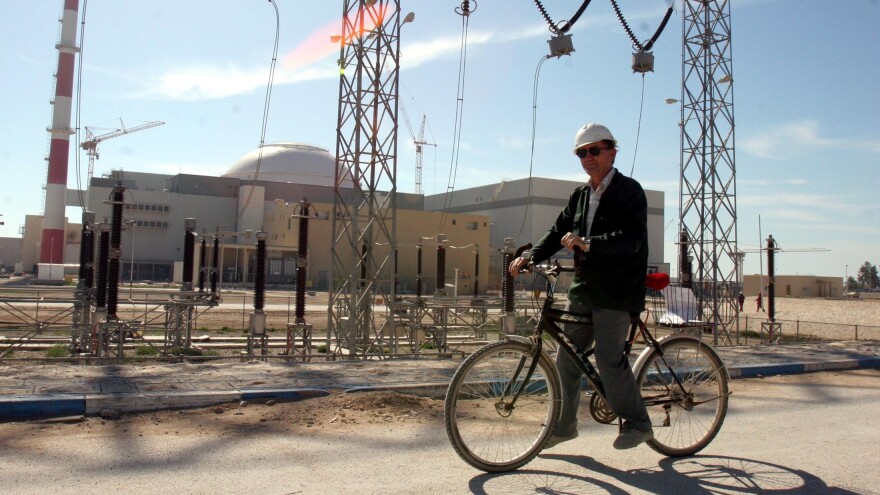Editor's Note: This updates an earlier version of this story and looks at key issues remaining as Iran and six world powers prepare to resume nuclear negotiations this week in Montreux, Switzerland.
Iran and the international powers, including the United States, are still abiding by the temporary agreement limiting Iran's nuclear program that was signed last November and has been extended multiple times.
At the talks that begin Thursday, the goal is to work out an initial political deal by the end of March and achieve a comprehensive, long-term deal by the end of June.
Here are the major sticking points:
1. Centrifuges And Uranium Enrichment
Iran has about 19,000 centrifuges capable of enriching uranium for nuclear energy, medical research — or nuclear weapons fuel. Of those, fewer than 10,000 are currently spinning, all relatively inefficient "first generation" models.
Tehran has already won a major concession from the international side, which acknowledged last November that Iran would be permitted to keep some form of uranium enrichment. Now the questions are how big should it be and how long should it be under international restriction?
Recent unconfirmed reports suggest that Washington might accept as many as 4,000 centrifuges, while Iran could live with 8,000 or so. The number is important, but so are other variables, such as what Iran does with the fuel those centrifuges produce. One option would be to ship it elsewhere, possibly Russia, which is providing fuel for Iran's only nuclear reactor, at Bushehr.
Another factor is how transparent the program is. U.N. nuclear inspectors currently have unprecedented access to Iran's main nuclear facilities; for the West, the greater the access those inspectors have, the more confidence the world can have that Iran's nuclear program is as peaceful as it has always claimed.
2. Sanctions
For Iran, getting international sanctions lifted is the main incentive for negotiating limits on its nuclear program. The Iranian economy has been battered by economic strictures on its oil and gas and banking sectors.
The problem for the West is that, as analyst Ali Vaez at the International Crisis Group has argued, turning sanctions on and off is a very tricky prospect. Some sanctions are controlled by the United Nations, some by the White House, some by the U.S. Congress, and some by the European Union. Congress in particular has shown reluctance to lift sanctions, and with the Republicans now in charge of both houses, new sanctions legislation is always a possibility.

3. Duration
Negotiators appear to be contemplating an agreement that would place significant restrictions on Iran for about 10 years, and then gradually eases them if Iran complies with its commitments. A senior U.S. official confirmed recently that the goal is a "one-year breakout time" for "double digit years."
"Breakout time" is the period it would take Tehran to amass enough fissile material for a single bomb. Critics argue that restricting Iran's program for only a decade doesn't solve the problem, and will simply "kick the can down the road."
Supporters say a decade or more of no Iranian nuclear problems is a positive outcome, especially compared with what may happen if the talks collapse and Iran pursues full-scale enrichment.
4. Possible Military Dimensions
This has been primarily an issue for the IAEA, which has several questions about past Iranian research and experiments that appear to have been part of weapons research.
Iran insists there are peaceful explanations for all the questions but has been reluctant to provide them, insisting this issue should be dealt with later. Experts say it's very likely Tehran did have a weapons program dating back to the Iran-Iraq war in the 1980s.
Former IAEA director Robert Kelley says, "I have said many times I believe there probably was one, particularly when [Iraqi dicatator] Saddam Hussein was the number one enemy. And I think it's sad that Iran has not found some political way to explain what they've done in the past."

5. Research and Development
Iran's current centrifuges are old, inefficient models known as IR-1s. This has been the basis on which Western negotiators calculate Iran's rate of enrichment. But under a nuclear agreement, Tehran wants the right to upgrade its centrifuges. Newer models could greatly shorten the "breakout time" in which Iran could theoretically produce weapons fuel if it chose to do so.
Tehran insists it must not be a "second-rate" member of the nuclear Non-Proliferation Treaty, or NPT. Figuring out when and how much upgrading Iran should be able to do under a multi-year agreement remains a tricky issue.
6. Arak Heavy Water Reactor
This still-incomplete heavy water facility near the city of Arak has been dubbed the "plutonium pathway" to a nuclear weapon. It runs on raw uranium, but produces plutonium.
This is precisely how a number of nuclear weapons states got their start. The West initially hoped Iran would offer to scrap the plant, but Tehran declared Arak one of its "red lines" that must be respected.
Western and Iranian officials have reportedly agreed in principle to modify the reactor so it produces much less plutonium.
7. Fordow Underground Enrichment Facility
The 2009 announcement that Iran had a secret uranium enrichment plant at Fordow, deep beneath a mountain not far from the holy city of Qom, sent shock waves through Israel and Western powers.
Iran insists it wasn't required to reveal the site's existence to the International Atomic Energy Agency, or IAEA, any earlier. But the bunkered facility fueled suspicions that Tehran was keeping the nuclear weapons option open. One proposed solution is to turn Fordow into a research facility.

8. Monitoring and Verification
Iran is being asked to accept unprecedented levels of inspections and monitoring of its nuclear program. And for every concession the international powers grant to Tehran allowing a larger program, the more transparency it will demand in return.
Analyst and former U.S. nuclear negotiator Robert Einhorn has written that the IAEA will "require monitoring authorities and procedures not ... found in any existing safeguards agreements."
Iran insists that it must be treated like any other nuclear energy state, and is demanding that any additional monitoring be for a limited time only.
9. Mistrust And Suspicion
Overcoming decades of mistrust will be essential if a comprehensive nuclear agreement is to succeed. American, Israeli and Gulf Arab hard-liners believe that no matter what Tehran says, it will never give up its nuclear weapons ambitions.
Iran's hard-liners, including Supreme Leader Ayatollah Ali Khamenei, are convinced that Washington will never be satisfied with an entirely peaceful Iranian nuclear program but will press to topple the Islamic Republic.
In response to such entrenched suspicions, supporters of nuclear diplomacy say, consider the alternative. Without an agreement, they say, there will be immediate consequences, all negative: The U.S. Congress will likely rush to enact even more sanctions on Iran, driving it further into isolation.
The unprecedented international sanctions regime that brought Iran to the negotiating table might begin to crumble, starting with Russia. And the most pragmatic and engaging figure in Iranian politics in years, President Hassan Rouhani, could be greatly weakened.
Copyright 2021 NPR. To see more, visit https://www.npr.org.


